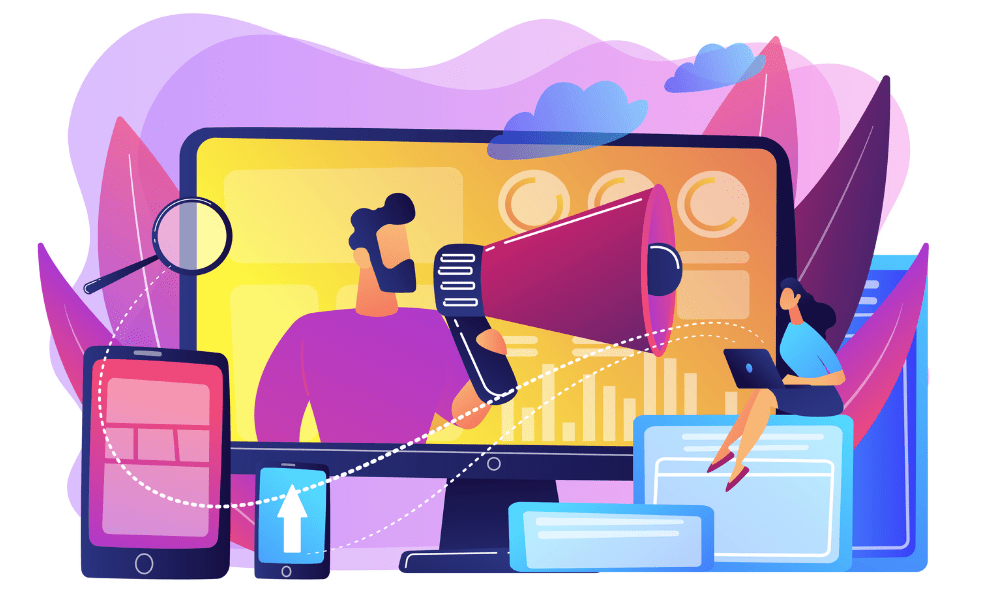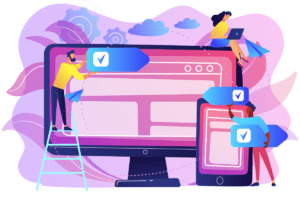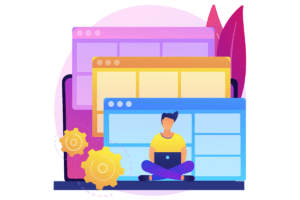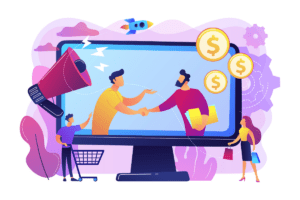B2B prospecting is one of the most critical components of any successful sales and marketing strategy. It’s the process of identifying potential business customers who might be interested in your solution and initiating contact to begin building a relationship. While that might sound simple, effective prospecting requires more than just cold calling or sending out mass emails. It requires strategy, timing, personalization, and tools that support meaningful outreach. In this article, we’ll break down the top 15 B2B prospecting strategies that you need to be using in order to generate qualified leads. First, let’s define what prospecting even is.
What Is B2B Prospecting?
B2B prospecting is the process of finding and connecting with businesses that are likely to become customers. This isn’t just about filling up your CRM, it’s about identifying the right companies, decision makers, and buying signals that point to a genuine need for what you have to offer. The most successful B2B teams don’t rely on a single channel or method to find leads. Instead, they take an omnichannel approach, combining outbound tactics with inbound insights to build a steady flow of qualified opportunities. Now that you have an understanding of what B2B prospecting is all about, let’s go over how to get started.
Top 15 B2B Prospecting Strategies
By now, you’re probably wondering how you can generate more qualified leads with prospecting. Check out our complete list of the top 15 B2B prospecting strategies that your team needs to leverage below.
1. Identify Anonymous Website Visitors
Many of your best leads are already checking out your website. They just haven’t introduced themselves yet. That’s where website visitor identification tools like Visitor Queue come in. With the help of Visitor Queue, you can see the companies visiting your site, along with what pages they visit, how long they view each page, and how they were acquired. This strategy gives you a leg up on traditional cold outreach. Instead of starting from scratch, you’re engaging with businesses that already know who you are and have shown interest in your solution. With the right integration, you can send these leads straight to your CRM and trigger personalized outreach sequences automatically. Try Visitor Queue for free for 14-days here.
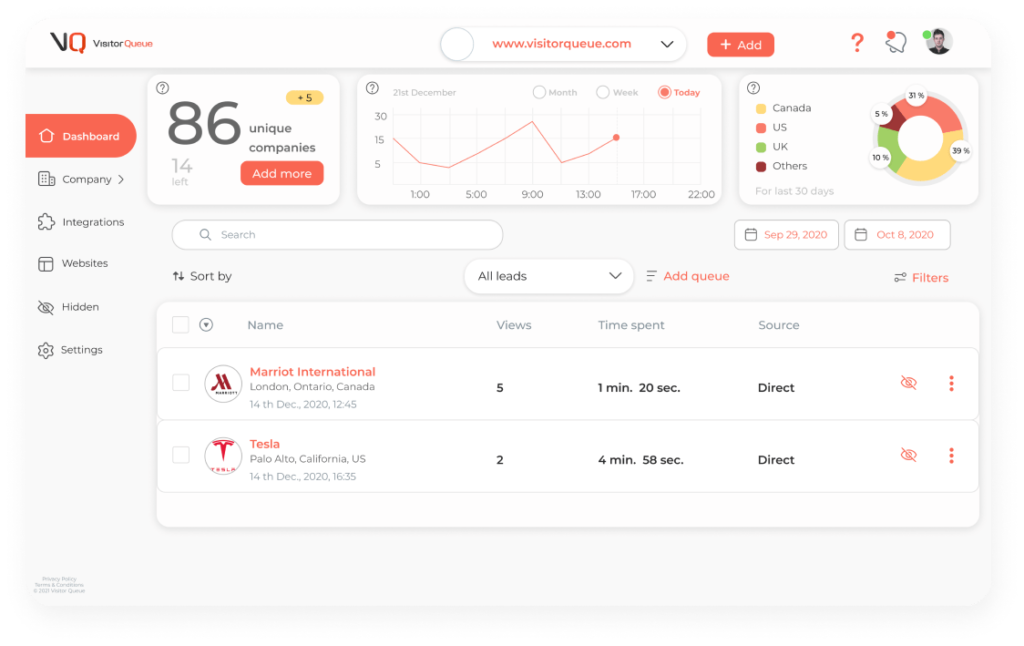
2. Leverage LinkedIn for Direct Outreach
LinkedIn is one of the best tools for B2B prospecting, when used strategically. Instead of pitching in a connection request, start by building a rapport. Engage with your target audience’s posts, comment thoughtfully, and share relevant insights of your own. Once you’ve established a connection, personalized InMails or messages that reference mutual interests or business challenges tend to perform far better than generic sales pitches. It’s important to remember that LinkedIn is a long game. The relationships you build here often take time to convert, but they’re more likely to result in high-quality leads.
3. Use Intent Data to Prioritize Outreach
Not every lead is ready to buy. In fact, only about 5% of your audience is ready to buy at any given time. And, trying to engage them too early can do more harm than good. That’s why intent data has become so valuable. This information, often sourced from third-party providers, gives insight into which companies are actively researching topics related to your product or service. By layering intent data into your prospecting process, you can prioritize outreach to businesses showing signs of interest, even if they’ve never visited your website or filled out a form.
4. Warm Up Cold Leads with Content
Cold outreach doesn’t have to feel cold. Sending helpful, relevant content to a prospect before pitching them can dramatically increase your chances of getting a response. This could be a case study that matches their industry, a whitepaper that addresses their pain point, or even a blog article that’s gotten traction in your network. Instead of immediately asking for a meeting, focus on offering value up front. By the time you follow up, you’ll be top of mind. And, much more likely to get a yes.
5. Optimize your Website for Lead Generation
If your website isn’t getting leads, you’re missing out. Clear calls to action, well-placed forms, exit-intent pop ups, and a live chat can all help convert your website visitors into leads. Try to A/B test different calls to action on your website to figure out what your visitors are responding the best to. Additionally, after someone does convert, they should be added to a drip campaign to follow up with complementary content.

6. Personalize Email Outreach Based on Buyer Personas
If you’re reaching out to all prospects with the same email template, you’re doing it wrong. Buyers expect outreach that speaks directly to their role, goals, and challenges. That’s why creating detailed buyer personas is essential. Once you know who you’re speaking to, whether it’s a VP of Sales or an IT Director, you can tailor your messaging, subject lines, and offers to match what matters most to them. Personalized emails consistently outperform generic ones, especially when you reference specific details like industry trends or relevant competitors.
7. Host Webinars
Webinars are a great way to engage potential prospects while demonstrating your expertise. When executed well, a webinar does more than educate. It also attracts attendees who are actively looking for solutions like yours. Make sure your topic addresses a real business challenge and includes a clear call to action. Even if attendees don’t convert right away, you’ll have their contact information, engagement data, and valuable insights to inform future outreach. Check out our article, How to Host a Webinar and Generate Leads, to learn more.
8. Implement Referral Programs
Your existing customers can be one of your most effective prospecting tools. If they’re happy with your solution, they likely know other businesses that would benefit too. But instead of waiting for referrals to happen organically, ask for them directly. Offer incentives or create a structured referral program that makes it easy for customers to connect you with others in their network. A warm introduction often shortens the sales cycle and builds trust right from the first conversation. There are a ton of referral software tools out there, like Referral Rock and Referral Factory, to help organize your campaigns.
9. Target Account-Based Campaigns
Account-Based Marketing, or ABM, flips the traditional lead gen model on its head. Instead of marketing to a broad audience, you identify a list of high-value accounts and create hyper-targeted campaigns designed just for them. This might include custom landing pages, tailored ads, direct mail pieces, or personalized video messages. While ABM requires more upfront work, the return on investment is often much higher because you’re investing time in the companies most likely to convert.
10. Use Sales Triggers to Time Outreach
The next one of our B2B prospecting strategies is implementing sales triggers. Sales triggers are events that signal a company might be in the market for your product. This could include hiring sprees, leadership changes, funding announcements, or product launches. Monitoring these changes via tools like Google Alerts or LinkedIn Sales Navigator allows you to reach out with a relevant, timely message. A well-timed pitch that acknowledges a company’s recent growth or shift in strategy shows you’ve done your homework. And, that you’re not just another rep sending out spam.

11. Collaborate with your Marketing Team
Prospecting doesn’t always mean jumping straight into sales mode. Many qualified leads aren’t ready to buy yet. And, that’s where collaboration with marketing becomes critical. Make sure you have nurture sequences in place that continue educating and engaging leads over time. This might include email drips, remarketing ads, or exclusive content offers that keep your solution top of mind. When a prospect finally reaches out, they’re often more informed and more likely to convert quickly.
12. Attend Industry Events
While digital strategies dominate most B2B prospecting discussions, in-person events still offer unmatched value. Conferences, trade shows, and local meetups give you a chance to connect with prospects face-to-face, build relationships, and gather direct feedback. Even virtual events can lead to high-quality opportunities when you engage with attendees before and after sessions. The key is preparation. Know who’s attending, plan your follow-up in advance, and be ready to offer something of value at every interaction.
13. Use a Live Chat
Live chat tools allow you to engage with website visitors while they’re actively exploring your offering. Instead of waiting for someone to fill out a form, you can start a real-time conversation that guides them to the next step. Some tools even allow you to trigger chat invitations based on visitor behavior, making your outreach feel timely and personalized. Not only does this improve the user experience, but it also gives your sales team more context for their follow-ups.
14. Strategic Partnerships
Sometimes the best leads don’t come from your own efforts, they come from partnerships. Aligning with complementary businesses gives you access to a shared customer base that already trusts the partner brand. This might include co-branded webinars, content collaborations, or simple referrals. It’s a win-win: your partner provides added value to their audience, and you gain warm introductions to potential customers.
15. Always Follow Up (Multiple Times!)
Following up is one of the most basic, yet often neglected, parts of prospecting. Many salespeople give up after one or two outreach attempts, but research shows that it often takes 8 touchpoints (sometimes even more!) to land a meeting. Timing, channel, and message all matter. But, consistency is key. Use automation tools to help manage follow-ups, but keep your tone personal and human. Persistence doesn’t mean being pushy. It means staying present and valuable until the time is right.
What’s Next?
B2B prospecting is a process designed to build genuine business relationships with the right people. While there is no one-size-fits-all approach, if you invest in the right strategies and stay focused on your ideal customer, the results will follow. As always, if you have any questions about using Visitor Queue to identify your website visitors, please let us know!
 Identify
Identify Personalize
Personalize Benchmark
Benchmark Agencies
Agencies Integrations
Integrations Case Studies
Case Studies Use Cases
Use Cases Blog
Blog Resources
Resources